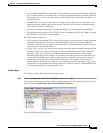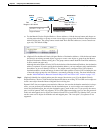
5-7
Cisco ASA Series Firewall ASDM Configuration Guide
Chapter 5 Configuring Twice NAT (ASA 8.3 and Later)
Configuring Twice NAT
a. For the Match Criteria: Original Packet > Source Address, click the browse button and choose an
existing network object or group or create a new object or group from the Browse Original Source
Address dialog box. The group cannot contain both IPv4 and IPv6 addresses; it must contain one
type only. The default is any.
b. (Optional) For the Match Criteria: Original Packet > Destination Address, click the browse button
and choose an existing network object or group or create a new object or group from the Browse
Original Destination Address dialog box. The group cannot contain both IPv4 and IPv6 addresses;
it must contain one type only.
Although the main feature of twice NAT is the inclusion of the destination IP address, the destination
address is optional. If you do specify the destination address, you can configure static translation for
that address or just use identity NAT for it. You might want to configure twice NAT without a
destination address to take advantage of some of the other qualities of twice NAT, including the use
of network object groups for real addresses, or manually ordering of rules. For more information,
see the “Main Differences Between Network Object NAT and Twice NAT” section on page 3-15.
Step 4 (Optional) Identify the original packet port (the mapped destination port). For the Match Criteria:
Original Packet > Service, click the browse button and choose an existing TCP or UDP service object or
create a new object from the Browse Original Service dialog box.
Dynamic NAT does not support port translation. However, because the destination translation is always
static, you can perform port translation for the destination port. A service object can contain both a
source and destination port, but only the destination port is used in this case. If you specify the source
port, it will be ignored. NAT only supports TCP or UDP. When translating a port, be sure the protocols
in the real and mapped service objects are identical (both TCP or both UDP). For identity NAT, you can
use the same service object for both the real and mapped ports. The “not equal” (!=) operator is not
supported.
Real: 192.168.1.1
Mapped: 10.1.1.1
Real: 10.1.2.2
Mapped: 192.168.2.2
NAT
Source Destination
Outside
Inside
10.1.2.2 ---> 10.1.1.1 192.168.2.2 ---> 192.168.1.1
Original Packet Translated Packet


















